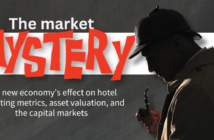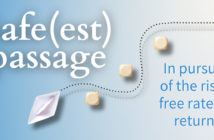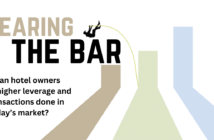A closer look at the key metrics lenders use to determine your maximum loan amount.
by RUSHI SHAH
Usually the first question a hotel owner will ask us is, “What size loan can I expect?” Non-recourse, non-traditional loans through firms such as Wall Street CMBS shops and life companies allow you to hedge your future market and rate risk, keep your personal balance sheet uncluttered and take cash out for any purpose. In order to offer up these attractive benefits, a lender will examine key metrics to determine the optimal combination of rate, term, proceeds, reserve requirements and cash out that will ensure your hotel’s cash flow can sufficiently cover the debt service throughout the life of the loan. Knowing your numbers upfront, or working with an experienced intermediary who knows how to leverage them in negotiations with the lender, can improve your results.
Net Cash Flow (NCF)
Net Cash Flow (NCF) – also known as Net Operating Income or NOI – is the owner’s net profit before paying for any debt (i.e. interest and principal) or any non-cash expenses (i.e. depreciation or amortization). Used to determine both the hotel’s value and loan amount, NCF is calculated by subtracting expenses (including a typical 3 percent management fee) and any reserves (such as a 4 percent reserve for FF&E) from your hotel’s last 12 to 36 months of revenue.
For example, a 90-room Hampton Inn located in a second or third tier market with $3,000,000 in revenue should have a NCF of about $1,050,000, or 35 percent of revenue.
Typically, the higher your net-profit or NCF, the higher your loan amount. This metric is also an example of where an experienced intermediary who knows his or her way around a hotel P&L can make an impact. Many one-time expenses and capital expenditures are often misallocated, and can be credited back to improve your NOI. Even if two properties have the same NCF, however, they may not qualify for the same loan amount. Market conditions, flag, property condition, location, operating efficiencies, remaining franchise term, and costs to build, buy or renovate the asset are all added into the mix.
RevPar Index
To determine how well your hotel is performing compared to its peers, lenders multiply your hotel’s average daily rate by its percent occupancy and measure it against your peer group’s performance on the STR report. Known as the RevPar Index, lenders use this metric as a barometer of how well the hotel is managed, and look for an index closer to 100 percent.
If your RevPar is lower than 100 percent, first confirm the competitive set is valid as the wrong group of competitors can sway your index scores up or down. A RevPar Index lower than 100 percent isn’t always a deal-breaker, but warrants a well-constructed explanation from your intermediary before the deal gets presented to an investor’s credit committee.
Capitalization Rates
To identify your hotel’s value – or the percent return an investor would receive if someone bought the property for cash – lenders divide NOI by the hotel’s estimated value (based on sales of comparable hotels in the same market) to arrive at a capitalization or cap rate. The lower the cap rate, the higher your hotel’s value. The maximum LTV allowed by the lender is applied to the calculated value to determine the loan amount. Cap rates in markets with few trades can vary widely, so make sure whomever represents you has the market knowledge to address any anomalies.
In the case of our example, based on the market’s past sales data, the hotel should be valued at an 8 percent cap rate and the estimated theoretical value of the hotel for financing would be $13,125,000.
Debt Yield & LTV Requirements
NOI is divided by the proposed loan amount to determine what the expected rate of return on a lender’s investment would be on day one, or its debt yield. When income is less predictable, as in markets where cash flow is less stable or for flags lower on the STR chain scale, lenders raise their required debt yield level, which reduces how much you can borrow. You can expect targets to range from 9 percent in primary markets for higher-end hotels, to 10 percent to 12 percent in secondary and tertiary markets for select service hotels. Bottom line, the lower the debt yield requirement, the higher the loan amount. Your final loan amount, however is still subject to the lender’s loan-to-value (LTV) cap which is usually 70 percent for select service hotels. Debt yield and LTV are the main drivers for leverage. As credit markets pull back on hotel lending debt yield often rises and LTVs drop.
With an NCF of $1,050,000, our example’s $13,125,000 estimated value and Debt Yield of 12 percent will garner a maximum loan amount of $8,750,000.
Total Cost Basis in the Property
Often overlooked, but important to credit committees and bond market rating agencies, is the total dollars invested for construction or capital improvements since the hotel was built or acquired. Known as your hotel’s total cost basis, it is especially critical for a cash out refinance as the new loan will be significantly higher than your current loan. The longer you’ve owned the property, the less important this factor.
Bottom line, to avoid missing out on higher proceeds, do the math upfront to ensure your numbers accurately represent your hotel. Improve your results even further by working with an experienced intermediary who understands the lender’s thresholds and knows how to negotiate around potential shortfalls. ■
Rushi Shah is CEO of Conlon Capital, a commercial mortgage banking firm formed by a merger with Aries Capital, which specializes in CMBS and other non-recourse lending solutions. Over the past 26 years, the Conlon and Aries teams have collectively funded more than $8B for hotel, multifamily and other commercial properties. Shah held previous positions at Northern Trust and is a member of AAHOA’s Founding & Allied Member Committee. Shah holds an MBA from The University of Chicago’s Booth School of Business.
Photo credit: NicoElNino/Shutterstock.com




